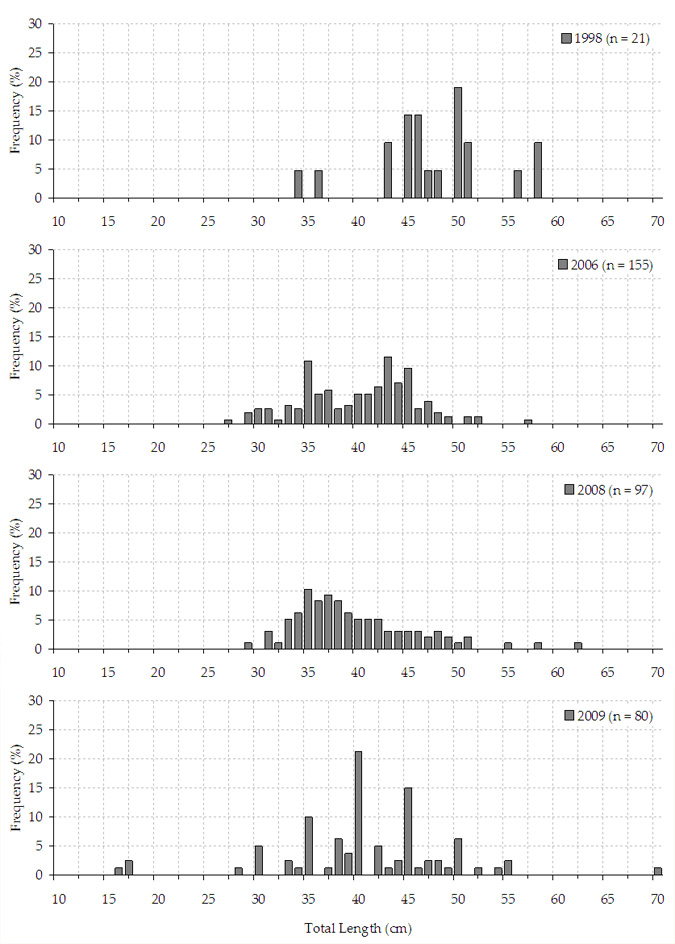Recreational fishery monitoring and fish habitat research - Mallacoota Inlet Fisheries Reserve

Table of Contents
Executive Summary
Main Findings from Monitoring/Assessment Projects
Introduction
Description of Lake Tyers
Management Plan Requirements
Purpose of this report
Fishing Values and Preferences
Methods
Results
Measuring Satisfaction Levels
Methods
Results
Target Species and Catch Composition Trends
MethodsResults
Preferred target species
Preferred target species - previous surveys
Species composition of catches
Species composition of catches – previous surveys
Proportion of recreational catch released
Proportion of recreational catch released – previous surveys
'General' angler diarists – target preferences and catch composition
Status of Key Target Fish Stocks
DiscussionConclusionsReferences
Acknowledgements
Appendices
Executive Summary
The Lake Tyers Fisheries Reserve Management Plan (LTFRMP), declared in 2007, identified a need for up-to-date information on recreational fishing activities and the status of key target fish stocks in order to maintain or enhance recreational fishing opportunities in the estuary. In order to meet this need, the LTFRMP specified the following monitoring and assessment approach:
- Establish periodic access point surveys of recreational fishing in Lake Tyers to obtain up-to-date information on the demographic profile of fishers, on the values they attach to fishing in the estuary, and on levels of satisfaction with recreational fishing experiences in Lake Tyers. The first 12-month survey was to be conducted within 2 years of the declaration of the LTFRMP, and at least one more 12-month survey is to be conducted within the remaining life of the current 10-year plan.
- Monitor recreational fishery trends (preferred target species; species composition of catches; catch rates, size composition and discard rates) for key species through periodic access point creel surveys and the recruitment of recreational fishers to an on-going voluntary angler diary program.
- Monitor the stock status of key recreational target fish species through the on-going collection of catch rate and size/age composition data from volunteer 'research' angler diarists, and from periodic access point creel surveys. The initial focus in Lake Tyers has been on black bream and dusky flathead.
In response to these needs, the Fisheries Research Branch sought and received funds from the Recreational Fishing Licence Trust Fund and Fisheries Victoria to conduct a 12-month access point survey in Lake Tyers, commencing December 2008, to obtain recreational fishing demographic, attitudinal and catch/effort data.
Funds from the Recreational Fishing Licence Trust Fund and Fisheries Victoria were also allocated for the establishment or expansion of on-going volunteer angler diary programs required to facilitate implementation of the LTFRMP and a number of other fishery management plans (Conron et al. 2010b).
Main Findings from Monitoring/Assessment Projects
The major findings from the above fishery monitoring and assessment projects are:
- A majority of Lake Tyers recreational fishers came from the immediate local area or from other parts of Gippsland. Visitors from Melbourne or other parts of Victoria fished in Lake Tyers most frequently during the warmer months of spring, summer and autumn. Few interstate or overseas recreational fishers were recorded during the survey.
- Most Lake Tyers recreational fishers surveyed were in the 18-49 or the 50-69 years age groups. In colder winter and spring months fishers were mainly in the 18-49 age category.
- Overall satisfaction with recreational fishing experiences in Lake Tyers is high (> 75% for both boat and shore-based anglers) and exceeds the performance target of 60% set in the LTFRMP.
- Anglers valued fishing in Lake Tyers for a variety of reasons. Some of these reasons are not directly related to catching fish, but all are underpinned by an expectation that fish can be caught. The majority of both boat-based and shore-based recreational fishers listed a non-catch value as their primary motivation for fishing.
- Black bream and dusky flathead as by far the most popular target species for both boat-based and shore-based recreational fishers in Lake Tyers.
- For most of the year black bream was the largest component of the boat-based recreational catch, followed by dusky flathead. Tailor and luderick were also significant components of the boat-based catch during cooler months of the year. Shore-based anglers mainly caught black bream in summer and autumn, luderick in winter and tailor in spring.
- Comparisons of recent and historical onsite survey data indicate that dusky flathead has become much more important as a recreational target species in the last decade, and subsequently contributes more to the overall catch now than in previous years. Conversely garfish, which was a major target species and a large component of recreational catches in the 1980s and 1990s, has become a minor target species and catch component – primarily for shore-based anglers.
- Available onsite survey data indicate that mean retained catch rates for black bream in Lake Tyers were similar in 2006/07 and 2008/09 (0.28 fish/angler hour) and slightly lower than for 1984/85 (0.38 fish/angler hour). The proportion of larger black bream (³ 35 cm TL) in retained recreational catches has fluctuated, being higher in 2008/09 (13%), 2006/07 (11%) and 1984/85 (about 9%) than it was in 1999 (1%).
- Catch rates of research angler diarists targeting bream in Lake Tyers since 2002/03 have been comparatively stable in the range 2.0-4.5 fish/angler hour.
- Ageing of bream caught by angler diarists indicates that in recent years the Lake Tyers black bream fishery has been dependant on 2 comparatively strong year classes, spawned in 1998/99 and 1999/00.
- Retained dusky flathead catch rates were similar for the 2006/07 and 2008/09 access point surveys (0.13 and 0.08 fish/angler hour respectively). The majority of flathead in the retained catch were in the 35 to 45 cm TL size range and few fish > 50 cm TL were reported.
- Catch rates of research angler diarists targeting dusky flathead in Lake Tyers rose steadily from 1999/2000 (0.5 fish/angler hour) to 2004/05 (3.3 fish/angler hour) and have since fluctuated in the range 1.3-3.8 fish/angler hour).
- Most dusky flathead caught by angler diarists in Lake Tyers since 2004/05 have been in the range 2+ to 5+ years old, with little evidence of either stronger or weaker year classes in recent years.
- The proportion of larger dusky flathead (³ 50 cm TL) in angler diarist catches has steadily declined from more than 20% in the early 2000s to less than 5% in the last few years. Available evidence suggests that this may be due to increased recreational fishing pressure on dusky flathead.
Introduction
This report describes the results of recent recreational fishery monitoring projects funded by the Recreational Fishing Grants Program and Fisheries Victoria and conducted in accordance with the requirements of the 2007 Lake Tyers Fisheries Reserve Management Plan (LTFRMP) (DPI 2007).
Description of Lake Tyers
Lake Tyers is a small estuary located 15 km east of Lakes Entrance, Victoria, with a total water area of approximately 25 sq km (Figure 1). The estuary consists of a main lake or lagoon at the entrance (average depth of 3 – 4 m) connected to two main riverine arms (Nowa Nowa and Toorloo) with numerous smaller arms (Hall 1984). Waters are often well-mixed as a result of wind driven circulation. The entrance to Lake Tyers is periodically closed by a sand bar, leading to variations in water quality (MacDon.
On 22 January 2004, Lake Tyers was declared a Fisheries Reserve under the provisions of Section 88 of theFisheries Act 1995. Following the closure of commercial fishing in 2003, fisheries management in Lake Tyers is focused primarily on maintaining or enhancing recreational fishing opportunities in the estuary.
Figure 1. Map of for Lake Tyers showing locations of boat ramps.
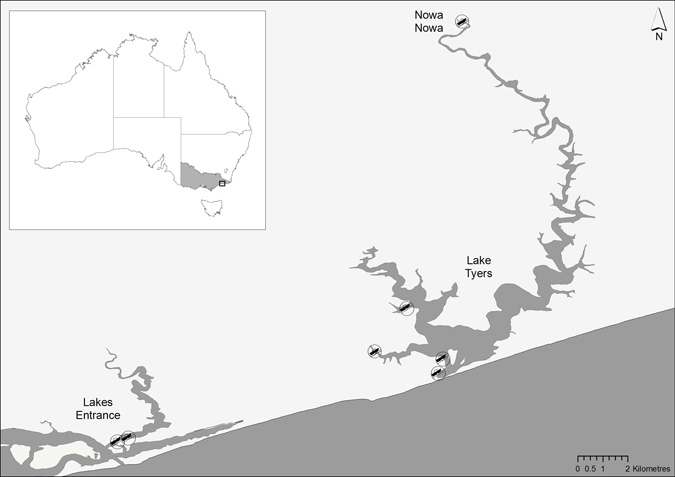
Management Plan Requirements
The broad management goal specified in the LTFRMP is to manage Lake Tyers fish stocks and the fisheries they support, and to identify and promote protection of important fish habitats, in a manner that is sustainable and which provides optimum social and economic benefits to all Victorians in accordance with ESD principles (DPI 2007). The following main objectives are also identified:
Social: to maintain, and where possible, enhance recreational fishing opportunities in Lake Tyers.
Biological: to conserve and ensure sustainable use of key fish stocks in the estuary.
Environmental: to identify and promote protection of the habitats and environments which are essential for production or maintenance of key fish stocks in the estuary.
Governance: to achieve maximum community participation, understanding and support for the management of fishing activities in the Lake Tyers Fisheries Reserve.
The LTFRMP recognised that over the previous two decades there had been insufficient information collected on Lake Tyers recreational fisheries or the status of key fish stocks to allow proper assessment of the appropriateness of existing fishery management arrangements for the estuary. In order to rectify this, the LTFRMP identified the need to establish several recreational fishery monitoring programs.
Key species identified in the LTFRMP are black bream (Acanthopagrus butcheri), dusky flathead (Platycephalus fuscus), silver trevally (Pseudocaranx sp.), river garfish (Hyporhampus regularis), southern sea garfish (Hyporhampus melanochir) and tailor (Pomatomus saltatrix) (DPI 2007).
Preliminary information from public consultations during the development of the LTFMP indicated that black bream and dusky flathead were the two most important recreational target species in Lake Tyers. Resources available for monitoring and assessing the status of key target fish stocks were initially focussed on these two species. Concerns expressed by some recreational fishers over the status of dusky flathead or black bream stocks in the estuary (DPI 2007) reinforce the need for adequate fisheries and stock status information to inform fishery management decisions.
Purpose of this report
Strategies listed in the 2007 LTFRMP that required the establishment of recreational fishery and stock status monitoring projects include:
Strategy 1: Monitor fishing values or preferences in Lake Tyers.
Strategy 2: Maintain or enhance levels of satisfaction with fishing opportunities.
Strategy 4: Assess the status of dusky flathead and black bream stocks and ensure sustainable fishing.
Strategy 5: Monitor catch composition and trends from other fishery species.
In response to these needs, the Fisheries Research Branch sought and received funds from the Recreational Fishing Licence Trust Fund and Fisheries Victoria for the following projects:
- Conduct of a 12-month access point survey of the Lake Tyers estuary, commencing December 2008, to obtain recreational fishing demographic, attitudinal and catch/effort data.
- Establish an on-going recreational general angler diary program for Lake Tyers to provide supplementary information on catch composition and catch trends for key species.
- Expand an on-going 'research' angler diary program to provide detailed catch rate and size/age structure data needed to monitor the recruitment of Lake Tyers black bream and dusky flathead, and to facilitate stock assessment and adaptive fishery management of these species in the estuary
The results of angler diary programs in Lake Tyers and other Victorian estuaries from their commencement to 2008/09 have been reported in detail elsewhere (Conron et al. 2010b).
This report presents:
- The results of the 2008/09 Lake Tyers access point survey, including data on:
-
- The demographic profile, fishing values and satisfaction levels of Lake Tyers anglers
- Target species
- Catch composition and discard rates
- Size/age composition of key species.
- A summary of results from Lake Tyers access point surveys in 1999 and 2006/07 (see Appendices) for comparison with the 2008/09 survey, including data on:
-
- Mean catch rates for black bream and dusky flathead
- Size composition of black bream and dusky flathead in Lake Tyers.
- Lake Tyers 'research' angler diary data for 2006/07 to 2008/09 on:
-
- Size composition of black bream and dusky flathead in Lake Tyers
- Age composition of black bream and dusky flathead in Lake Tyers.
- Lake Tyers 'general' angler diary data for 2006/07 to 2008/09 on:
-
- Targeting preferences and catch composition of diarists.
Fishing Values and Preferences
Strategy 1 of the LTFRMP identifies a need to collect information on the demographic profile of Lake Tyers recreational fishers and on the values they attach to fishing in the estuary. This information is needed to determine what constitutes a satisfying recreational fishing experience in the estuary, and therefore, what management actions may help to maintain or enhance recreational fishing opportunities.
METHODS
The most recent profile of Lake Tyers recreational fishers was obtained from more than 310 interviews conducted during seasonal (summer, autumn, winter and spring) access point creel surveys in Lake Tyers from December 2008 to November 2009. Age and residential postcode information were recorded from a randomly selected interviewee in each fishing party. Recreational fishers indicated whether they were locals or visitors, answered questions on their main motivations for going recreational fishing, and identified the specific reasons they chose to fish in Lake Tyers. From the information given, it was determined whether or not they were eligible to hold a Recreational Fishing Licence (RFL).
Future surveys will provide updated information on the profile of Lake Tyers recreational fishers and an indication of any changes in fishing-associated values.
Primary motivations for fishing have been grouped into non-catch (do not directly depend on fish being caught) or catch (depend on fish being caught) categories. However, all types of motivations for fishing are underpinned by an expectation that fish can be caught.
RESULTS
The 2008/09 survey results indicate that for most of the year a majority of Lake Tyers fishers come from the local area or other parts of Gippsland (Figure 2). These two categories collectively constituted just over 50% of anglers during summer, and around 60% during winter and spring when visitors from Melbourne and other parts of Victoria were at their lowest. The percentage of locals was lowest in autumn (7%), when visitors from Melbourne and other parts of Victoria constituted the majority of fishers.
Only a small percentage of Lake Tyers fishers were interstate visitors; this category was only recorded in summer and winter (Figure 2).
Most Lake Tyers fishers surveyed (>80%) were in the 18-49 or 50-69 years age groups (Figure 3), with the 18-49 group slightly more dominant in winter and spring. A small percentage of <18 and individuals who were aged 70 or over were recorded in every month, except for spring when no fishers surveyed were older than 69 (Figure 3).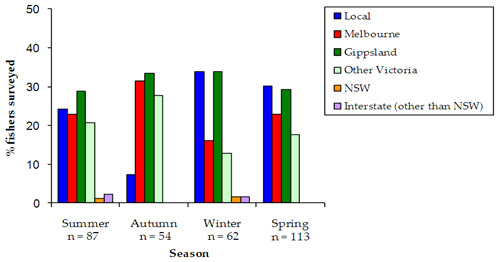
Figure 2. Origin of fishers selected randomly from fishing parties participating in onsite surveys in Lake Tyers between December 2008 and November 2009.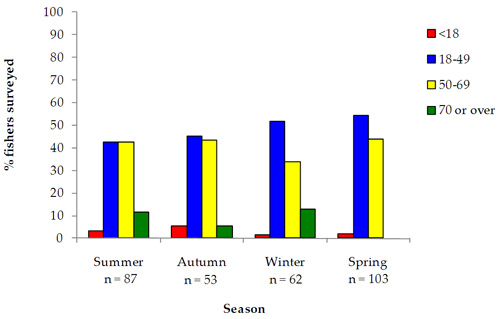
Figure 3. Percentage of age categories of individuals selected randomly from fishing parties participating in onsite surveys in Lake Tyers between December 2008 and November 2009.
Figure 4. Percentage of fishers randomly selected from fishing parties participating in onsite surveys in Lake Tyers between December 2008 and November 2009 who were deemed eligible for a recreational fishing licence (RFL).
The 2008/09 survey results indicated that for most of the year (winter, spring and summer) about 80% of Lake Tyers fishers were eligible to hold a RFL while about 20% were exempt (Figure 4). In autumn the proportion of fishers exempt from the need to hold an RFL rose above 40%.
A substantial majority of Lake Tyers boat-based (71%) and shore-based (87%) anglers cited a non-catch value as their most important motivation for participating in recreational fishing (Figure 5). The most common reason given by all anglers was to relax. The second most common motivation stated by boat-based anglers (20%) was the enjoyment of the sport (Figure 5a), whilst spending time with family and enjoying nature rated higher with shore-based anglers (Figure 5b). Being alone or participating in fishing competitions were the motivations least favoured by Lake Tyers recreational fishers (Figure 5).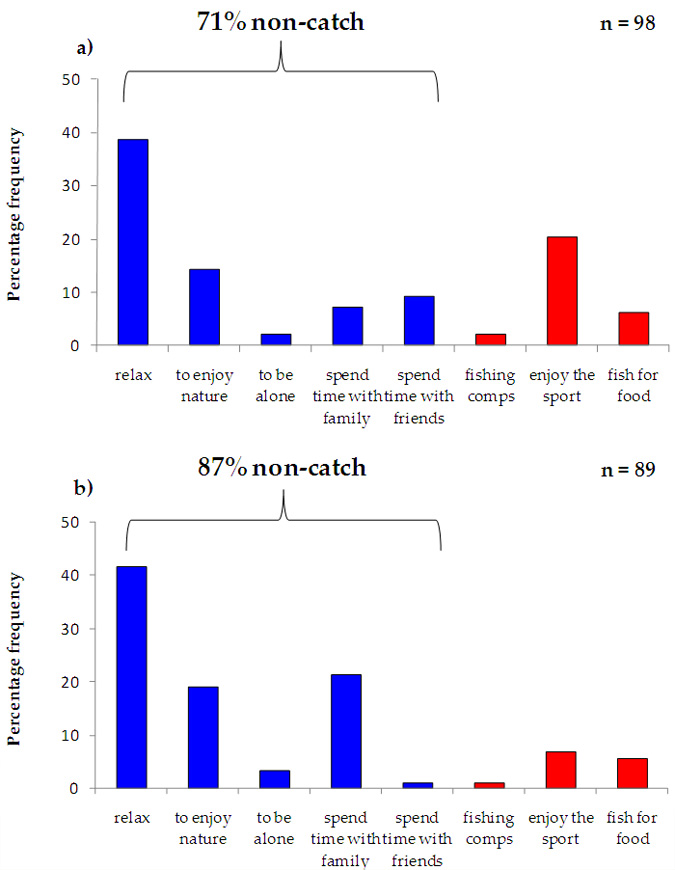
Figure 5. Reasons for fishing which were rated as most important by a)boat-based anglers and b) shore-based anglers participating in onsite surveys in Lake Tyers between December 2008 and November 2009. Values are either non-catch (do not depend on fish being caught: blue bars) or catch (depend on fish being caught: red bars).
Almost all boat-based anglers (97%) rated having good boat access as an important reason for fishing in Lake Tyers, while the majority of shore-based anglers (81%) rated good bank access as important (Figure 6). Both boat and shore-based anglers reported that having a location that is easy to get to and having a good chance of catching a target species were important to their fishing experience in Lake Tyers (Figure 6). Finding a private spot was rated as important by a higher percentage of boat-based anglers (86%) than shore-based anglers (56%). Having access to town services was highly rated by fewer than 50% of Lake Tyers fishers.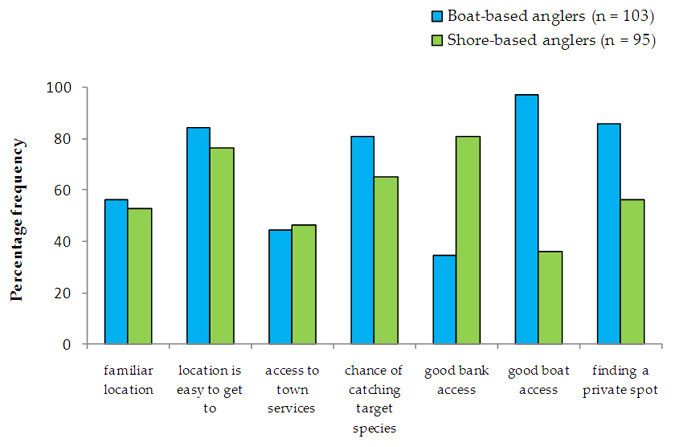
Figure 6. Reasons for fishing specifically in Lake Tyers which were rated as either 'Very important' or 'Quite important' by boat-based (blue bars) and shore-based (green bars) anglers participating in onsite surveys in Lake Tyers between December 2008 and November 2009.
Measuring Satisfaction Levels
Strategy 2 of the LTFRMP identifies the need to conduct periodic surveys to initially benchmark and then detect any changes in levels of recreational fishing satisfaction in Lake Tyers. The performance indicator set in the LTFRMP is a minimum of 60% of fishers satisfied with fishing opportunities (DPI 2007).
Methods
An initial profile of levels of satisfaction among Lake Tyers recreational fishers was obtained from interviews conducted during seasonal access point creel surveys in Lake Tyers between December 2008 and November 2008. Anglers were asked how satisfied they were with the overall quality of fishing in Lake Tyers in the previous 12 months. A total of 194 anglers participated in the satisfaction survey, of which 101 were boat-based anglers and 93 were shore-based anglers.
Results
Overall satisfaction levels were high, with 84% of boat-based anglers and 78 % of shore-based anglers surveyed either 'Very satisfied' or 'Quite satisfied' with their fishing experience in Lake Tyers (Figure 7). This is well above the performance indicator of a 60% minimum level of satisfaction specified in the LTFRMP. Of those that stated that they were not satisfied, the main reason given was poor catches. Other reasons for not being satisfied included lack of local knowledge, not enough boat ramp access and poor water clarity.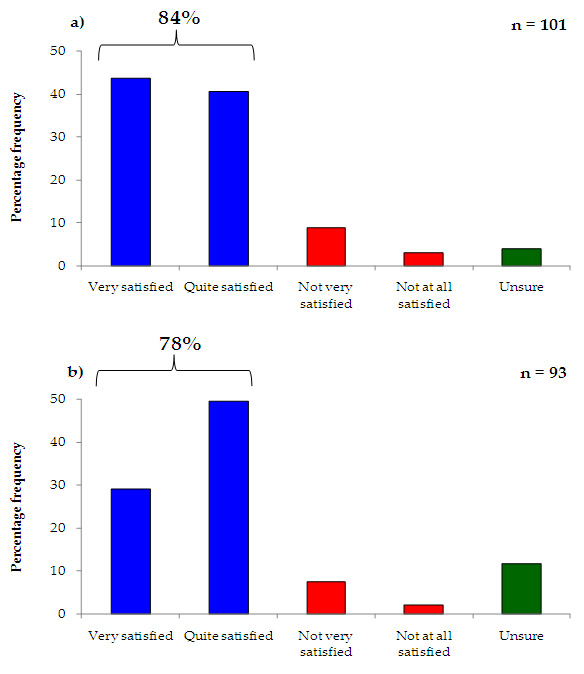
Figure 7. Level of satisfaction recorded from a) boat-based and b) shore-based anglers participating in onsite surveys in Lake Tyers when asked to rate their overall fishing experience in the previous 12 months.
Target Species and Catch Composition Trends
Strategies 1 and 5 of the LTFMP identify a need for ongoing periodic monitoring of recreational fishing in Lake Tyers to identify, and then detect, subsequent changes to preferred target species and the species composition of the catch. This information is needed to ensure that fishery monitoring, assessment, and management activities are focused on the most important target species.
Methods
Information on preferred fishing target species, the species composition of retained catches, and discard rates, was obtained from interviews with recreational fishers during the 2008/09 Lake Tyers access point creel survey. A total of 506 fishing parties were interviewed, including 302 boat-based and 204 shore-based anglers.
These results were compared with the results of on-site surveys in Lake Tyers in 1984/85, 1999 and 2006/07 to identify any changes in target preferences or species composition of catches during that period.
Results
PREFERRED TARGET SPECIES
The 2008/09 survey indicated that black bream and dusky flathead were by far the two most popular recreational target species in Lake Tyers. Depending on the season, bream were targeted by 47%-56% of boat-based fishers and 25%-43% of shore-based fishers, while dusky flathead was targeted by 17%-52% of boat-based fishers and 16%-48% of shore-based fishers (Table 1, Figures 8 and 9). Other minor target species included luderick and tailor for boat-based fishers, and these plus garfish, Australian salmon and yellow-eye mullet for shore-based fishers.
During summer and autumn a small percentage of boat-based fishers and a much higher percentage of shore-based fishers (40%-51%) were not targeting any particular species but were fishing for anything they could catch (Table 1, Figures 8 and 9).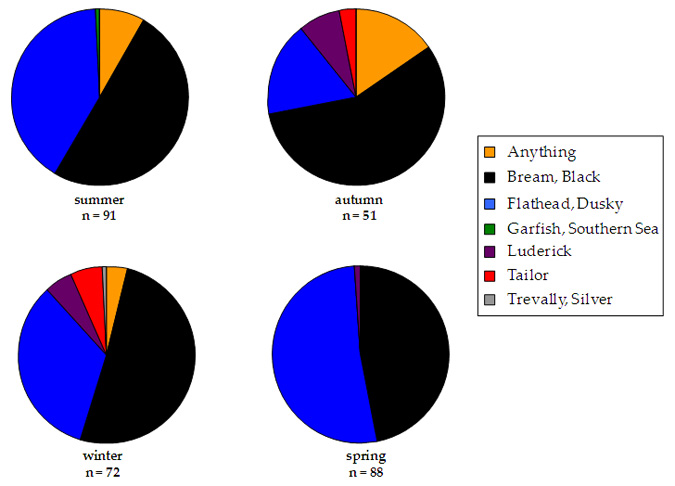
Figure 8. Target species identified by boat-based anglers participating in seasonal onsite surveys in Lake Tyers between December 2008 and November 2009.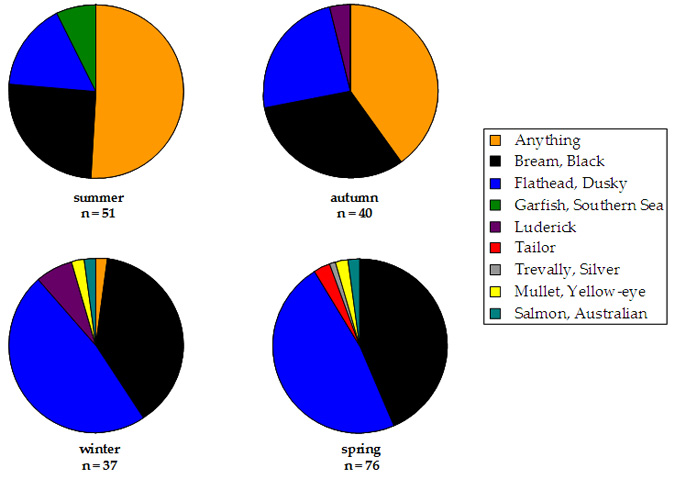
Figure 9. Target species identified by shore-based anglers participating in seasonal onsite surveys in Lake Tyers between December 2008 and November 2009.
Table 1. Key target species identified by boat and shore based anglers in onsite surveys in Lake Tyers between December 2008 and November 2009.
|
Type |
Season |
n |
% fishing |
Most popular target species |
2nd most popular target species |
Other species targeted |
|---|---|---|---|---|---|---|
|
Boat |
Summer |
91 |
8 |
Black bream (50%) |
Dusky flathead (41%) |
Garfish |
|
Boat |
Autumn |
51 |
15 |
Black bream (56%) |
Dusky flathead (17%) |
Luderick, tailor |
|
Boat |
Winter |
72 |
4 |
Black bream (51%) |
Dusky flathead (34%) |
Luderick, tailor, silver trevally |
|
Boat |
Spring |
88 |
0 |
Dusky flathead (52%) |
Black bream (47%) |
Luderick |
|
Shore |
Summer |
51 |
51 |
Black bream (25%) |
Dusky flathead (16%) |
Garfish |
|
Shore |
Autumn |
40 |
40 |
Black bream (32%) |
Dusky flathead (24%) |
Luderick |
|
Shore |
Winter |
37 |
2 |
Dusky flathead (48%) |
Black bream (39%) |
Luderick, yellow-eye mullet, Australian salmon |
|
Shore |
Spring |
76 |
0 |
Dusky flathead (48%) |
Black bream (43%) |
Tailor, silver trevally, yellow-eye mullet, Australian salmon |
PREFERRED TARGET SPECIES - PREVIOUS SURVEYS
A 12-month roving intercept creel survey in Lake Tyers in 1984/85 (Hall and MacDonald 1985) found that the most popular target species were black bream (54% of anglers), garfish (28%), and dusky flathead (9%). Separate results for boat-based and shore-based fishers or for different seasons were not provided.
Information from the same survey indicated that fewer than 5% of anglers were using artificial lures as fishing tackle in Lake Tyers.
An access point creel survey during summer and autumn months of 1999 found that black bream, dusky flathead and garfish were the main target species for boat-based fishers while bream and garfish were the only target species reported by the small number of shore-based fishers (Appendix 1a). Mullet, silver trevally, tailor and whiting were identified as minor target species for boat-based fishers (Appendix 1a).
An access point creel survey during summer, autumn and winter months of 2006/07 found that dusky flathead had overtaken black bream as the most popular target species for boat-based fishers during summer and autumn (Appendix 1b). Black bream was also an important target species in these seasons, and was the main target species in winter. A significant proportion of shore-based anglers and summertime boat-based anglers were not fishing for any particular target species. Tailor, luderick, snapper and prawns were identified as lesser target species.
The small number of shore-based anglers surveyed in autumn 2007 only reported black bream (61%) and luderick (8%) as target species (Appendix 1b).
SPECIES COMPOSITION OF CATCHES
The 2008/09 survey indicated that black bream and dusky flathead were the two main species in the retained catches of boat-based anglers (Figure 10). Bream was the largest component of summer, autumn and winter catches (40%-61%), while dusky flathead was prominent in spring, summer and autumn catches (30%-45%). Tailor (16%-34%) and luderick (10%-15%) also contributed significantly to catches in some seasons (Figure 10).
Black bream dominated summer and autumn catches by shore-based anglers, but were a relatively minor component at other times (Figure 11). Dusky flathead was a minor component of spring and summer catches, but was not reported by the small number of shore-based anglers interviewed in autumn and winter. Tailor and luderick made substantial contributions to catches in some seasons, and a range of other species, including garfish, yellow-eye mullet, crabs and Australian salmon, were minor components of shore-based catches (Figure 11).
SPECIES COMPOSITION OF CATCHES – PREVIOUS SURVEYS
The 1984/85 roving intercept creel survey in Lake Tyers (Hall and MacDonald 1985) found that the largest component of the annual retained recreational catch was garfish (51%), followed by black bream (39%) and mullet (7%). All other species, including dusky flathead, constituted less than 3% by number and less than 10% by weight of the total catch. Separate results for boat-based and shore-based fishers or for different seasons were not provided.
The access point creel survey during summer and autumn months of 1999 found that garfish were the single largest component of retained catches by both boat-based and shore-based fishers (Appendix 1c). Black bream was the second largest component of boat-based catches, but was overshadowed by mullet in shore-based catches. Other species recorded in catches included silver trevally, tailor, dusky flathead and whiting (Appendix 1c).
The access point creel survey during summer, autumn and winter months of 2006/07 found that black bream and dusky flathead dominated both boat-based and shore-based retained catches (Appendix 1d). Bream was the largest component of autumn and winter catches, while dusky flathead was the largest component of summer catches. Tailor were a significant component of boat-based catches in all seasons, while luderick and leatherjackets were minor components of autumn shore-based catches.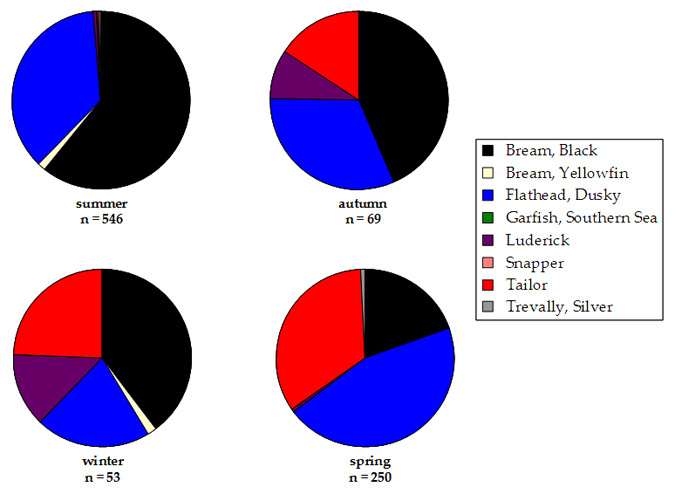
Figure 10. Species caught by boat-based anglers who participated in seasonal onsite surveys in Lake Tyers between December 2008 and November 2009.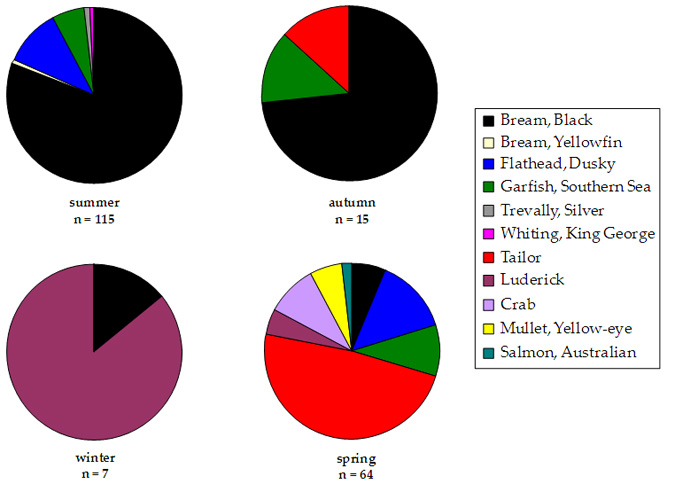
Figure 11.Species caught by shore-based anglers who participated in seasonal onsite surveys in Lake Tyers between December 2008 and November 2009.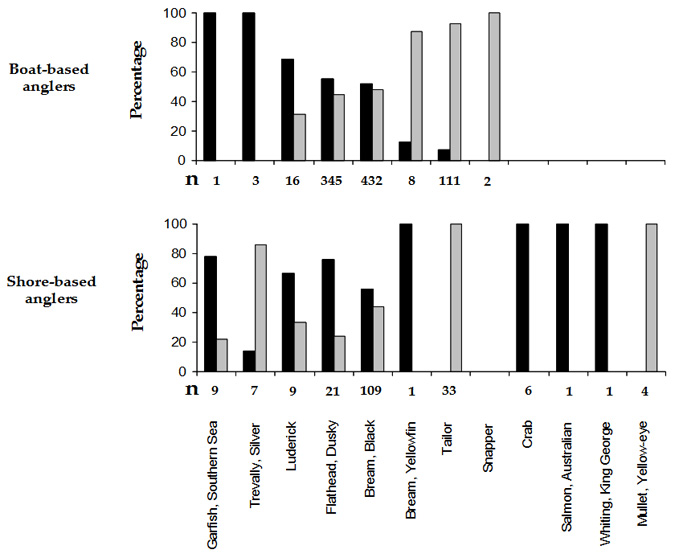
Figure 12. Percentage of retained (black bars) and released (grey bars) fish for each species caught in Lake Tyers by boat and shore-based anglers participating in onsite surveys between December 2008 and November 2009 (n = number of fish).
PROPORTION OF RECREATIONAL CATCH RELEASED
Data from interviews conducted during the 2008/09 access point survey indicate that a majority of black bream, dusky flathead and luderick caught by Lake Tyers anglers during this period were retained, while nearly all tailor were released (Figure 12). Boat-based anglers released substantially more dusky flathead (45%) than did shore-based anglers (25%). Nearly all garfish caught were retained because there is no legal minimum size for this species and the survival rate of released garfish is low. The small numbers of other species reported in catches (Figure 12) prevented any meaningful assessment of release rates for these species.
PROPORTION OF RECREATIONAL CATCH RELEASED – PREVIOUS SURVEYS
No information on proportions of catches released was obtained during the Lake Tyers 1984/85 survey.
Anglers interviewed during the 1999 access point creel survey indicated that they released more black bream than they kept, but kept most of the dusky flathead, garfish and tailor that they caught (Appendix 1e). Anglers kept and released approximately equal proportions of mullet and Australian salmon. The small number of shore-based anglers interviewed indicated that nearly all the fish they caught were released.
Interview data from the 2006/07 access point survey indicate that a majority of black bream caught were released, while a majority of dusky flathead and tailor were retained (Appendix 1f). The small number of shore-based anglers interviewed in autumn 2007 indicated that they kept more fish than they released (Appendix 1f).
'GENERAL' ANGLER DIARISTS – TARGET PREFERENCES AND CATCH COMPOSITION
During the period 2006/07 to 2008 a total of 16 volunteer recreational fishers were recruited as 'general' angler diarists to provide information about their fishing activities in Lake Tyers. Unlike 'research' angler diarists, 'general' angler diarists were not asked to modify their recreational fishing methods or their target preferences, and only provided information about their normal fishing activities in the estuary.
Information provided by Lake Tyers general angler diarists indicated that on most trips throughout the year they targeted either black bream or dusky flathead (Figure 13). Other species targeted during some seasons included luderick, tailor, Australian salmon, silver trevally and snapper (Figure 13).
The largest component of catches reported by general angler diarists in all seasons was black bream, most of which were kept (Figure 14). Bream were particularly dominant in autumn and winter catches when there was less targeting of dusky flathead or other species.
Dusky flathead were caught all year round, but were most prevalent in spring and summer. A majority of dusky flathead caught were kept. The only other significant species in general angler diarist catches was luderick, nearly all of which were kept (Figure 14).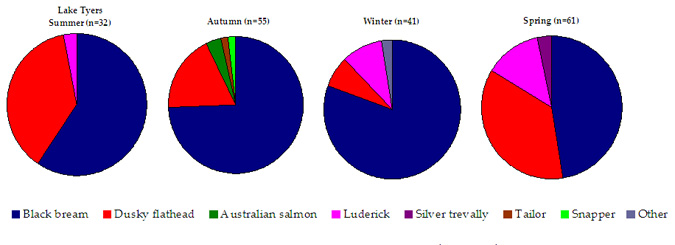
Figure 13. Species targeted by general angler diarists fishing in Lake Tyers from 2006/07–2008/09 (n=number of species targeted).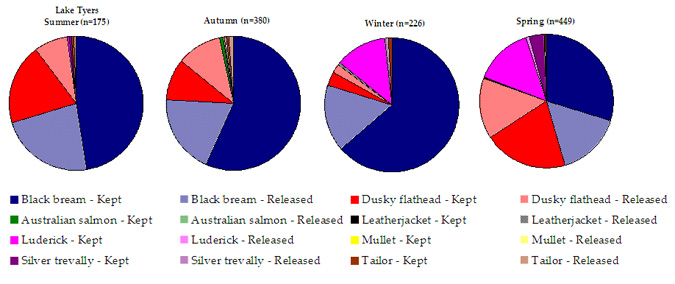
Figure 14. Catch composition of fish caught (kept and released) by general angler diarists fishing in Lake Tyers from 2006/07–2008/09 (n=number of fish caught).
Status of Key Target Fish Stocks
Strategy 4 of the LTFRMP identified a need to establish ongoing or periodic monitoring of year class strength and fishery recruitment patterns for key recreational target fish species in Lake Tyers to facilitate stock assessment and adaptive fishery management decision making for these species. The LTFRMP specifies that the initial stock assessment focus in Lake Tyers will be on black bream and dusky flathead.
Methods
Expert anglers who targeted black bream or dusky flathead in Lake Tyers were identified and recruited to participate in an ongoing voluntary 'research' angler diary program. Information recorded and provided by these anglers includes:
- Time spent fishing
- Fishing location
- Species targeted and caught
- Length of each fish caught
- Number of rods used
- Bait and hook type/sizes used.
'Research' anglers were asked to adjust their fishing techniques (hook sizes, baits and fishing locations) in order to catch the largest possible size range of black bream and dusky flathead. All catch data including the release of under-size fish, were recorded in diaries, and all fish caught were measured. Anglers were asked to record details of every fishing trip, including those in which no fish were caught to avoid non-reporting of poor catches.
The results of angler diary programs in Lake Tyers and other Victorian estuaries from their commencement to 2008/09 have been reported in detail elsewhere (Conron et al. 2010b). This report presents summaries derived from Lake Tyers angler diary records for the period 2006/07 to 2008/09.
Information on targeted catch rates and the size composition of black bream and dusky flathead catches was also obtained from Lake Tyers access point creel surveys conducted during January to April 1999, December 2006 to June 2007, and December 2008 to November 2009.
Otoliths were obtained for ageing purposes from black bream and dusky flathead supplied by angler diarists or measured during access point creel surveys. The resulting age/length keys were then applied to length distribution data to generate an estimate of the age composition of recreational catches of these two species.
Black Bream
CATCH RATES
Available onsite creel survey data indicate that mean retained catch rates for black bream in Lake Tyers were similar in 2006/07 and 2008/09 at about 0.28 fish/angler hour (Appendix 2a). The mean retained catch rate for black bream from the 1984/85 survey (Hall and MacDonald 1985) was slightly higher at 0.38 fish/angler hour. This comparison of catch rates should, however, be treated with some caution because of the different survey methods used (roving intercept survey of incomplete trips in 1984/85; access point survey of completed trips in 2006/07 and 2008/09). No catch rate data are available from the 1999 access point survey.
Catch rates of research angler diarists targeting black bream in Lake Tyers since 2002/03 have been comparatively stable in the range 2.0-4.5 fish/angler hour (Conron et al. 2010b and see Figure 15). The angler diarist catch rates are considerably higher than those derived from on-site surveys because (i) the angler diarist catch rates include both retained and released bream, and (ii) angler diarists are mostly avid and skillful anglers whereas on-site surveys sample anglers with a broad range of avidity and experience.
SIZE COMPOSITION
From 2006/07 to 2008/09, 'research' angler diarists reported catching a total of 723 black bream in Lake Tyers ranging from 11 to 43 cm total length (TL) (Figure 16). Black bream below the legal minimum length (LML) comprised between 6% and 33% of annual catches. The LML for black bream increased from 26 cm to 28 cm TL in March 2009.
The length distribution of black bream caught in 2008/09 indicates that research anglers are able to catch bream from about 15 cm TL upwards, and shows some evidence of a new size class of pre-recruit bream becoming vulnerable to research angler fishing methods (Figure 16).
Analysis of length data for all bream caught by Lake Tyers 'research' angler diarists since 2002/03 (Conronet al. 2010b) shows annual catches with a single length mode that progressively increases from about 24 cm TL in 2002/03 to about 31 cm TL in 2008/09. There is little evidence of smaller bream (<20 cm TL) in any of these catches until 2008/09.
A total of 512 black bream were measured as part of access point creel surveys in Lake Tyers in 1999, 2006/07 and 2008/09 (Appendix 2c). The length of black bream in retained catches ranged from 25 to 46 cm TL. The proportion of retained black bream that were 35 cm and above was low in 1999 (1%) but similar in 2006/07 (11%) and 2008–09 (13%). The length distribution of 369 bream measured during the 1984/85 on-site survey (Hall and MacDonald 1985) displayed a single size mode at about 28 cm TL, and the proportion of fish 35 cm TL or above was about 9%.
AGE COMPOSITION
Ageing of black bream indicates that catches of Lake Tyers 'research' angler diarists in 2007/08 and 2008/09 contained fish from 1+ to 21+ years old but were dominated by two strong year classes spawned in 1998/99 and 1999/2000 (Figure 17). During 2008/09 in particular, 66% of the total reported bream catch comprised fish from one of these two strong year classes. Ageing of angler diarist catches prior to 2007/08 (Conron et al. 2010b) indicates that these two strong year classes have dominated the Lake Tyers black bream population since the early 2000s.
The 2008/09 age composition data do, however, suggest that a slightly more abundant year class spawned in 2005/06 may soon contribute to the Lake Tyers bream fishery.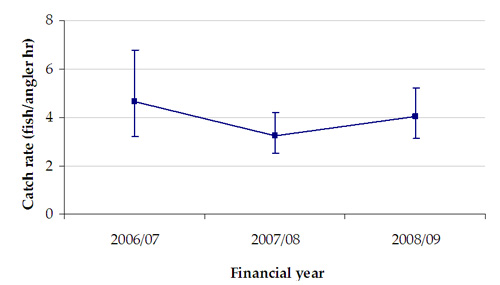
Figure 15. Estimated mean catch rates (± 95% confidence limits) of black bream caught by research anglers fishing in Lake Tyers from 2006/07 to 2008/09.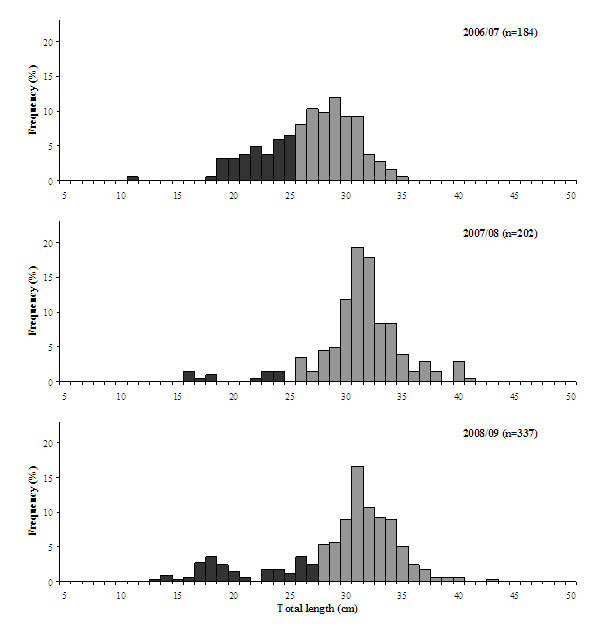
Figure 16. Length-frequency distribution of black bream caught by research anglers fishing in Lake Tyers from 2006/07 to 2008/09 (n=number of fish measured). Fish below the legal minimum length (LML) are indicated by black bars. Fish above the LML are indicated by grey bars.
*The LML for black bream increased from 26 cm to 28 cm TL in March 2009.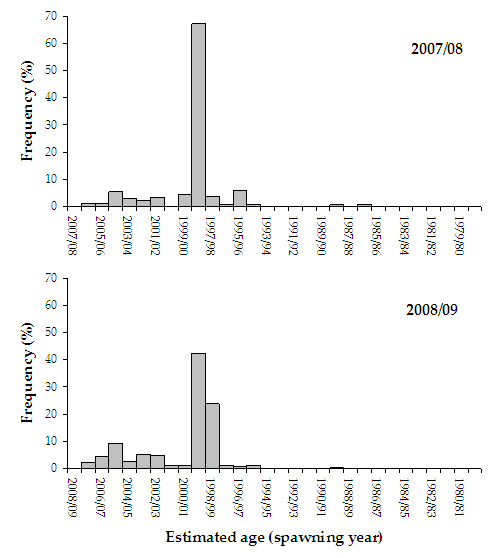
Figure 17. Age frequency distribution of black bream caught by research anglers fishing in Lake Tyers from 2007/08 to 2008/09. No black bream samples collected during 2006/07 were aged..
Dusky flathead
CATCH RATES
No dusky flathead catch rate data are available from the 1984/85 or 1999 on-site surveys. Dusky flathead catch rates were comparable for the access point surveys in 2006/07 (0.13 fish/angler hour) and 2008/09 (0.08 fish/angler hour) (Appendix 2b).
Catch rates of research angler diarists targeting dusky flathead in Lake Tyers rose steadily from 1999/2000 (0.5 fish/angler hour) to 2004/05 (3.3 fish/angler hour) and have since fluctuated in the range 1.3-3.8 fish/angler hour (Conron et al. 2010b and see Figure 18). The angler diarist catch rates are considerably higher than those derived from on-site surveys because (i) the angler diarist catch rates include both retained and released dusky flathead, and (ii) angler diarists are mostly avid and skillful anglers whereas on-site surveys sample anglers with a broad range of avidity and experience.
SIZE COMPOSITION
From 2006/07 to 2008/09, 'research' angler diarists reported catching a total of 387 dusky flathead in Lake Tyers ranging from 10 to 82 cm TL (Figure 12). Despite a desire for 'research' angler diarists to catch the broadest possible size range of dusky flathead, few pre-recruit fish (<25 cm TL) were caught during this period (Figure 19). The LML for dusky flathead increased from 25 cm to 27 cm TL in March 2009.
In most years since 1999/2000, a majority of dusky flathead caught by Lake Tyers 'research' angler diarists were in the 30 cm – 50 cm TL length range (Conron et al. 2010b). Despite this, significant numbers of dusky flathead less than 30 cm TL were caught in 1999/2000 and 2003/04, and the proportion of larger dusky flathead (> 50 cm TL) in angler diarist catches has steadily declined from more than 20% in the early 2000s to less than 5% in the last few years (Conron et al. 2010b).
A total of 257 dusky flathead were measured as part of access point creel surveys undertaken in Lake Tyers in 2006/07 and 2008/09 (Appendix 2d). The length of dusky flathead in retained catches ranged from 16 to 70 cm TL. In 2008/09, the majority of dusky flathead were 35 to 45 cm TL (Appendix 2d).
Dusky flathead size composition data were not available from the 1984/85 and 1999 on-site creel surveys of Lake Tyers.
AGE COMPOSITION
Ageing of dusky flathead indicates that catches by Lake Tyers 'research' angler diarists from 2006/07 to 2008/09 contained fish from 0+ (first year of life) to 10+ years old. However, in each year more than 80% of fish were 2+ to 5+ years old, and there were few fish older than 6+ (Figure 20).
Ageing of angler diarist catches from 2004/05 and 2005/06 (Conron et al. 2010b) indicated a similar dusky flathead age structure to that in 2006/07 to 2008/09, and provided little evidence of either stronger or weaker year classes entering the fishery in recent years.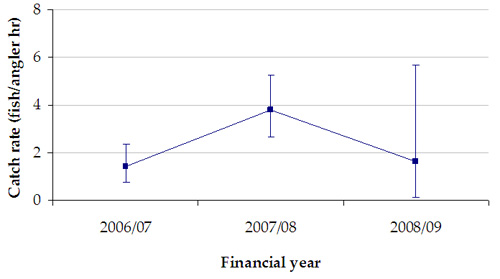
Figure 18. Estimated mean catch rates (± 95% confidence limits) of dusky flathead caught by research anglers fishing in Lake Tyers from 2006/07 to 2008/09.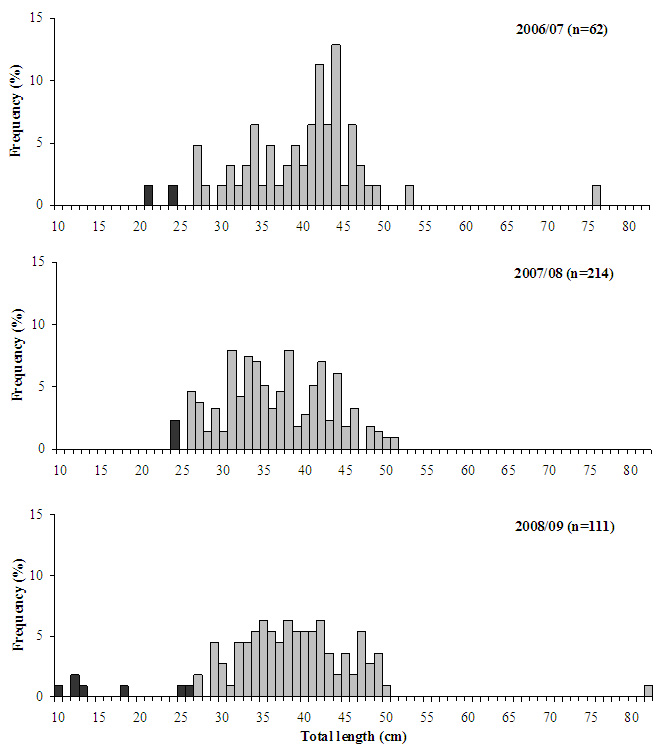
Figure 19. Length (TL)-frequency distribution of dusky flathead caught by research anglers fishing in Lake Tyers from 2006/07 to 2008/09 (n=number of fish measured). Fish below the LML are indicated by black bars. Fish above the LML are indicated by grey bars.
*The LML for dusky flathead increased from 25 cm to 27 cm TL in March 2009.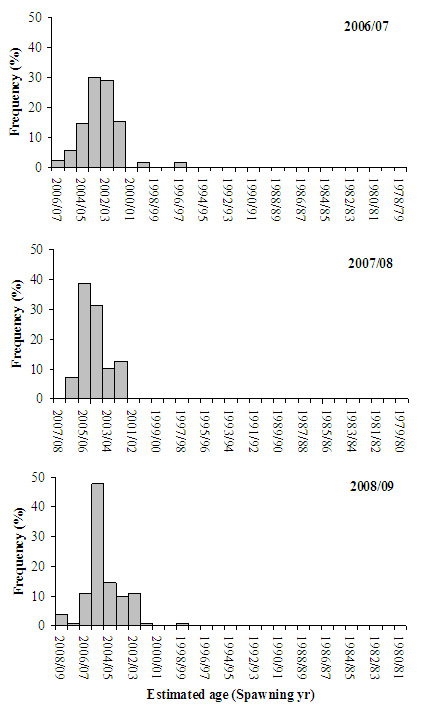
Figure 20. Age frequency distribution of dusky flathead caught by research anglers fishing in Lake Tyers from 2006/07 to 2008/09.
Discussion
The 2008/09 access point survey revealed that Lake Tyers is a popular recreational fishing destination year round for Gippsland residents, and is seasonally popular for anglers visiting from Melbourne and other parts of Victoria. Local residents frequently fish in Lake Tyers in all seasons except autumn. This drop in the number of locals in autumn coincided with the highest percentage of visitors from Melbourne and other parts of Victoria, and may be the result of a desire to avoid crowded fishing areas. A similar pattern of visitors being prevalent during warmer months, while locals and Gippsland residents make up a higher proportion of anglers during colder months, has been observed in recent recreational fishing access point surveys in Mallacoota Inlet (Kent et al. 2010) and Anderson Inlet (Conron et al. 2010a).
The only previous information available on the demographic profile of Lake Tyers recreational fishers was from a roving intercept creel survey conducted in1984/85 (Hall and MacDonald 1985). This survey found that over a 12-month period, about a third of Lake Tyers fishers were 'locals' (defined as anyone who travelled from a permanent residence to fish the estuary) while about two-thirds were 'visitors' (defined as anyone who travelled from a temporary residence to fish the estuary). No information was provided on the origins of visiting anglers, or on seasonal variations in the demographic profile of Lake Tyers fishers.
The 2008/09 access point survey found that for most of the year about 80% of Lake Tyers recreational fishers were eligible to hold a recreational fishing licence (RFL), while about 20% were exempt from the need to hold a RFL. In autumn 2009, the proportion of Lake Tyers anglers exempt from the need to hold a RFL rose to more than 40%. The reason for this seasonal increase is not clear. A similar access point survey in Mallacoota Inlet in 2007/08 found that the proportion of recreational fishers that were exempt from the need to hold a RFL was in the range 20% – 25% across all seasons (Kent et al. 2010).
There is now considerable evidence which shows that motivations for going recreational fishing vary among fishers and can be either directly related to catching fish or only indirectly related (referred to as 'non-catch' motivations or values) (Holland and Ditton 1992, Manfredo et al. 1996, Connelly and Brown 2000).
In 2008/09, a substantial majority of Lake Tyers recreational fishers surveyed (both boat and shore-based) identified a 'non-catch' value (e.g. "to relax"; "to enjoy nature"; "to spend time with family/friends") as their primary motivation for going fishing. These results are consistent with other surveys in Victorian estuaries (Conron et al. 2010a, Kent et al. 2010) and elsewhere in Australia (Henry and Lyle 2003, Ormsby 2004) where 'non-catch' values have been the most commonly given reasons for going on fishing trips. However, a significant minority of boat-based anglers both in Lake Tyers (this report) and Mallacoota Inlet (Kent et al.2010) identified the catch-related value 'enjoyment of the sport' as their primary motivation, suggesting that their satisfaction levels are more likely to be related to catch rates.
Satisfaction with recreational fishing in Lake Tyers was high in 2008/09, with more than three quarters of boat-based and shore-based anglers satisfied with their recreational fishing experience in the 12-months prior to the survey. This level is well above the 60% minimum performance standard set in the management plan. Similar or even higher levels of satisfaction with recreational fishing experiences have been recorded from recent surveys in Mallacoota Inlet (Kent et al. 2010) and Anderson Inlet (Conron et al.2010a).
Sutton (2007) found that recreational fishers in Queensland who placed great importance on relaxing and/or catching fish as reasons for going fishing were more likely than other anglers to report specific problems (e.g. poor facilities, crowded fishing areas) that adversely affected their fishing experience and prevented them achieving desired outcomes. The high level of satisfaction recorded in the 2008/09 access point survey suggests that currently such issues are not widely perceived as problems in Lake Tyers. The high proportion of Lake Tyers fishers motivated by 'non-catch' values also suggests that levels of satisfaction are less likely to be strongly tied to fluctuations in catch rates.
In the past two decades there has been a substantial shift in both the preferred target species of Lake Tyers anglers and the species composition of their catches. A mid 1980s survey (Hall and MacDonald 1985) indicated that black bream and garfish were the two most popular target species and constituted about 90% of overall retained catches. At the same time dusky flathead was targeted by fewer than 10% of Lake Tyers anglers and constituted less than 3% of the retained catch.
A limited seasonal survey in summer and autumn 1999 indicated that black bream and garfish were still popular target species and made up most of the overall retained catch. By 2006/07, dusky flathead had overtaken black bream as the most popular target species for boat-based anglers and was the second largest component of boat-based catches after bream. Garfish had virtually disappeared as a target species and as a component of both boat-based and shore-based catches. The most recent survey (2008/09) confirmed black bream and dusky flathead as the main target species for both boat-based and shore-based anglers in Lake Tyers, and indicated that dusky flathead had become a significant component of shore-based catches.
The increased targeting and catching of dusky flathead in Lake Tyers and in other East Gippsland estuaries since the late 1990s is likely to be due to a shift in target preferences of anglers, although it is possible that an increased abundance of dusky flathead could have been a contributing factor. This shift has been paralleled by an increasing use of highly effective artificial lures – including soft plastics – in East Gippsland estuaries (Stokie et al. 2010) and elsewhere. Reasons for the decline in targeting and catching of garfish are not so obvious, but could include a decline in the popularity of the specialised angling methods used to catch garfish, a decline in garfish abundance, or both.
Targeting and catching of other species such as tailor, luderick, silver trevally and Australian salmon in Lake Tyers has fluctuated over the years with no clear pattern. It is likely that occasional increased targeting of these species is a reflection of good recruitment following successful reproduction in the estuary, or migration of marine species into the estuary when the estuary entrance is open.
There are both similarities and differences in the preferred target species and catch composition of Lake Tyers volunteer 'general' diary anglers compared with fishers interviewed during recent access point surveys. The main reason for any differences are that angler diarists, being volunteers, are more likely to be avid and experienced anglers, and therefore their target preferences and fishing methods may not be representative of the full spectrum of Lake Tyers recreational fishers.
While both groups targeted black bream heavily, 'general' diary anglers fished more for dusky flathead, especially in spring and summer. The species composition of catches for both groups were broadly similar, but black bream and dusky flathead contributed more to the overall catch for 'general' diary anglers. Comparisons suggest that the species composition of catches reported by 'general' diary anglers can be used as a good representation of what other recreational fishers are catching, but the target preferences of diary anglers may be narrower than those of the general angling population.
Black bream are estuarine residents (Sarre and Potter 1999), and populations of this species are subject to large fluctuations in reproductive success and year class strength driven primarily by environmental factors. Angler diary monitoring (Conron et al. 2010b) indicates that Victorian bream fisheries are characterised by occasional recruitment of strong year classes which then support the fishery through a number of years of average to poor recruitment until the next strong year class comes along.
Black bream catch rates in Lake Tyers have been fairly stable since the early 2000s. This stability has been sustained primarily by the recruitment of two strong year classes spawned in the late 1990s. It is expected that bream catch rates in Lake Tyers will decline in the next few years as spawning success and recruitment since the early 2000s has been average or below average.
There is some evidence of increased abundance of juvenile bream (16–20 cm TL) in the 2008/09 catches of Lake Tyers 'research' angler diarists. This may be an early indication of a stronger year class spawned in 2005/06 (Conron et al. 2010b). It will take several more years for these fish to reach legal minimum size and be recruited to the recreational fishery.
Catch rates of dusky flathead by Lake Tyers research angler diarists increased substantially from 1999/00 to 2004/05, and have remained comparatively high since then (Conron et al. 2010b). This trend is likely to be at least partly due to the increasing effectiveness of fishing methods used to target dusky flathead, but may also be due to increased abundance of this species in the estuary.
Data collected by 'research' angler diarists has also shown a substantial decline since the early 2000s in the proportion of large fish (≥ 50cm TL) in Lake Tyers dusky flathead catches, despite evidence of steady recruitment supporting the fishery over recent years (Conron et al. 2010b). A similar but less pronounced trend has been observed in dusky flathead catches reported from Mallacoota Inlet (Conron et al. 2010b, Kent et al. 2010). The most plausible explanation for this trend is due to increased targeted fishing pressure on large – mostly female - flathead.
In New South Wales it was found that 50% of females reached sexual maturity at approximately 56 cm TL (Gray and Barnes 2008). If the same is true in Victoria, a significant proportion of female dusky flathead are being removed from the fishery before they reproduce. This reduction in large females may in turn affect the spawning capacity of the stock and future recruitment to the fishery. Further research on the reproductive biology of dusky flathead in eastern Victorian estuaries is required to understand the potential impact of this trend on the dusky flathead stock and, therefore, the fishery.
In the meantime, it may be appropriate as a precautionary measure to review the effectiveness of current fishery management measures in protecting the reproductive capacity of dusky flathead stocks in Lake Tyers and elsewhere. There is likely to be considerable support from recreational fishers for such a review. For example, in a recent access point survey the vast majority (93%) of anglers in Mallacoota Inlet thought the dusky flathead LML should be increased (Stokie et al. 2010).
Angler interview responses during recent access point surveys suggest that the Lake Tyers recreational fishery is currently providing a satisfying fishing experience for most anglers. Given that recent angler catch rates of key species (e.g. black bream and dusky flathead) in Lake Tyers have been lower than those in other Victorian fisheries like Mallacoota Inlet (Kent et al. 2010), it is likely that most anglers surveyed based their satisfaction levels on fulfilment of 'non-catch' values. However, the presence of fish and the possibility of catching fish underpin all motivations for recreational angling, and if catch rates decline to very low levels satisfaction levels may also drop.
Conclusions
The majority of recreational fishers are satisfied with fishing opportunities in Lake Tyers. Satisfaction levels exceed the 60% minimum set in the LTFRMP. Periodic monitoring should continue to ensure any changes in attitude are detected.
Large amounts of visitors from Gippsland fished in Lake Tyers in all seasons. Locals accounted for a high proportion of recreational fishers in Lake Tyers for much of the year, except in autumn when visitors came from Melbourne and other parts of Victoria. The majority of fishers in Lake Tyers were in the age-group 18-49 or 50-69, and the demographic information obtained suggests that most fishers in Lake Tyers are eligible for a recreational fishing licence.
Non-catch values are more important than catch values to recreational fishers in Lake Tyers. The most important motivation behind participation in recreational fishing given by both boat and shore-based fishers was 'to relax'.
The species being caught are consistent with those being targeted. The main target species overall were black bream and dusky flathead. Dusky flathead has become a more important species in Lake Tyers in the last 10 years, replacing garfish as a major target and catch species. The other species more commonly caught in Lake Tyers are luderick and tailor.
There have been significant changes in targeting preferences and in the species composition of Lake Tyers recreational catches in the last 20 years. Targeting and catches of dusky flathead have increased substantially while garfish have declined from being a major to only a minor target species.
Whilst the black bream catch has been stable over the past 5 years, the dusky flathead catch rate has fluctuated. Recent catch rates for dusky flathead and black bream are lower than in Mallacoota Inlet.
There is some evidence of a decline in large (≥ 50cm TL) flathead, which is concerning since most fish this size are female. Further information is required on the reproductive biology of dusky flathead to make informed management decisions.
Based on results from this study, garfish, silver trevally, luderick, black bream and dusky flathead, are more likely to be retained after being caught in Lake Tyers. Tailor are likely to be released.
The establishment of periodic access point surveys and ongoing angler diary monitoring of the Lake Tyers recreational fishery has met and will continue to meet the requirements of the Lake Tyers Fisheries Reserve Management Plan.
Available data indicate that the fishery is popular year round with Gippsland residents and seasonally with visitors from Melbourne and elsewhere, and that most fishers are happy with their current recreational fishing experiences in the estuary.
References
Connelly, N. A. and Brown, T. L. (2000). Options for maintaining high fishing satisfaction in situations of declining catch rates. Human Dimensions of Wildlife. 5: 18-31.
Conron, S., Kent, J. and Hindell, J. (2010a). Recreational fishery monitoring and fish habitat research needed to facilitate management of the Anderson Inlet Fisheries Reserve. Recreational Fishing Grant Program Final Report. Department of Primary Industries, Victoria.
Conron, S., Bridge, N. F., Grixti, D., Ward, M. and Stokie, T. K. (2010b). Angler diary monitoring of recreational target fish stocks in selected Victorian estuaries. Recreational Fishing Grant Program Final Report. Department of Primary Industries, Victoria.
DPI (2007). Lake Tyers Fisheries Reserve Management Plan 2007. Fisheries Victoria Management Report Series No. 43.
Gray, C. A. and Barnes, L. M. (2008). Reproduction and growth of dusky flathead Platycephalus fuscus in NSW estuaries. NSW Department of Primary Industries, Fisheries Final Report Series No. 101.
Hall, D. N. and MacDonald, C. M. (1985). A survey of recreational fishing and aquatic resource use in Lake Tyers, Gippsland. Fisheries and Wildlife Service, Victoria. Marine Fish Report No. 6.
Henry, G. W. and Lyle, J. M. (Eds.) (2003). The National Recreational and Indigenous Fishing Survey. Final Report on FRDC Project No. 99/158. 188pp. Published by NSW Fisheries, Cronulla.
Holland, S. M. And Ditton, R. B. (1992). Fishing Trip Satisfaction: a Typology of Anglers. North American Journal of Fisheries Management. 12: 28-33.
Kent, J., Hindell, J. and Conron, S. (2010). Recreational fishery monitoring and fish habitat research needed to facilitate management of the Mallacoota Inlet Fisheries Reserve. Recreational Fisheries Grant Program Final Report. Department of Primary Industries, Victoria.
Manfredo, M. J., Driver, B. L., Tarrant, M. A. (1996). Measuring leisure motivation: a meta-analysis of the recreation experience preference scales. Journal of Leisure Research. 28: 188-213.
Ormsby, J. (2004). A review of the social, motivational and experiential characteristics of recreational anglers from Queensland and the Great Barrier Reef. Great Barrier Reef Marine Park Authority, Australia.
Sarre, G. A. And Potter, I. C. (1999). Comparisons between the reproductive biology of black breamAcanthopagrus butcheri (Teleostei: Sparidae) in four estuaries with widely differing characteristics. International Journal of Salt Lake Research. 8: 179-210.
Stokie, T.K., Bridge, N.F., MacDonald, M. and Conron, S. (2010). Evaluation of changes to dusky flathead catch limits in Mallacoota Inlet. Recreational Fishing Grant Program – Research report.
Sutton, S. G. (2007). Constraints on recreational fishing participation in Queensland, Australia. Fisheries. 32: 73-83.
Acknowledgements
This project was funded by the Recreational Fishing Licence Trust Fund using Recreational Fishing Licence fees and Fisheries Victoria (Project number No. R/07/08/13).
We wish to express our thanks to the many recreational anglers who have, over the years, freely provided us with information needed for this study.
Special thanks go to the fishing diary anglers Lyn Barr, Lex Blythman, Ken Bradley, Glenda Brain, Chris Chipperfield, Wally De Lange, Stan Dumbleton, Ray Goding, John Harrison, Colin Hannah, Carl Hodgkins, Don Howe, Graeme Merryful Peter McDiarmid, Marjie Millen, Allan Rogers, Robert Schroader, Barry Smith and Peter Spehr.
We would also like to thank Di Crookes, and the team from Wildlife Unlimited including Fiona Stevens, Heidi Murphy and Jim and Jenni Reside for their efforts in interviewing several hundred recreational anglers as part of the angler survey. We also like to acknowledge the efforts of Matt Ward who assisted with the running of survey work.
Thanks to Karina Ryan for producing the catch rate graphs.
Thanks to Pam Oliveiro, Katrina Halse, Vicki Nicholas and Tina Whillock for data editing and entry.
Thanks to Dr James Andrews and Jon Presser for their comments on this report.
Appendices
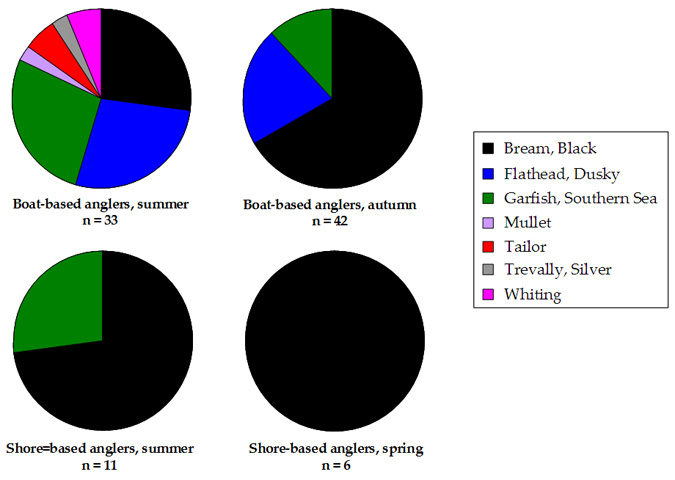
APPENDIX 1A: TARGET SPECIES IDENTIFIED BY BOAT AND SHORE-BASED ANGLERS PARTICIPATING IN SEASONAL ONSITE SURVEYS IN LAKE TYERS FROM JANUARY – APRIL 1999.
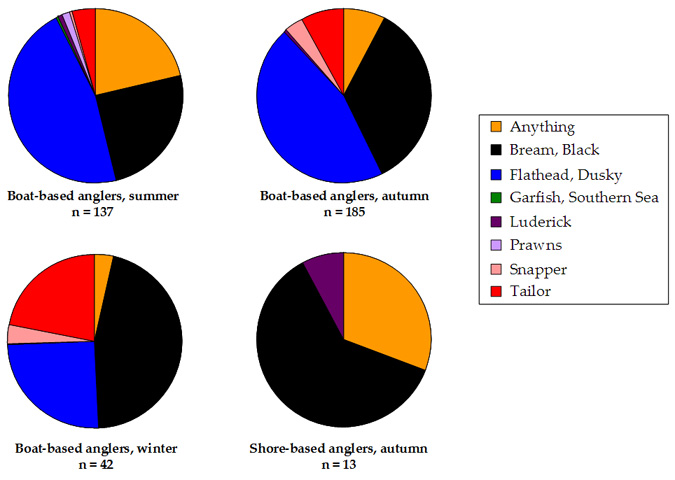
APPENDIX 1B. TARGET SPECIES IDENTIFIED BY BOAT AND SHORE-BASED ANGLERS PARTICIPATING IN SEASONAL ONSITE SURVEYS IN LAKE TYERS FROM DECEMBER 06 TO JUNE 07.
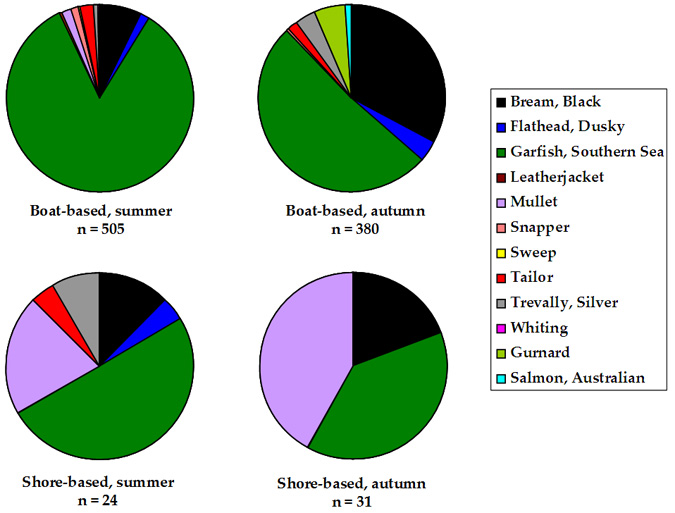
APPENDIX 1C. SPECIES CAUGHT BY BOAT AND SHORE-BASED ANGLERS WHO PARTICIPATED IN SEASONAL ONSITE SURVEYS IN LAKE TYERS FROM JANUARY – APRIL 1999.
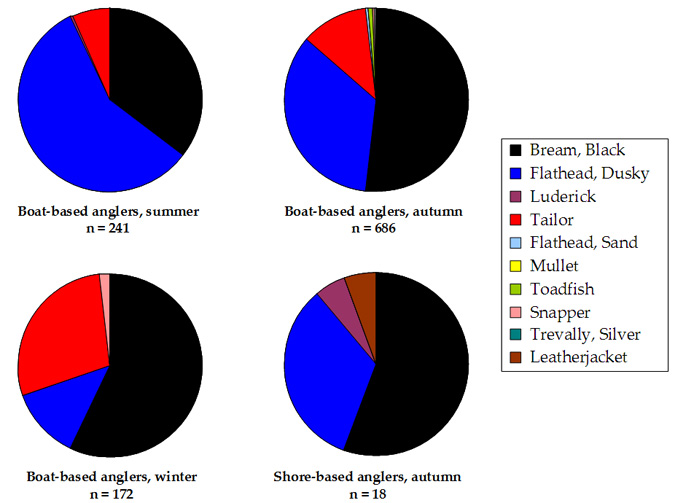
APPENDIX 1D. SPECIES CAUGHT BY BOAT AND SHORE-BASED ANGLERS WHO PARTICIPATED IN SEASONAL ONSITE SURVEYS IN LAKE TYERS BETWEEN DECEMBER 2006 AND JUNE 2007.
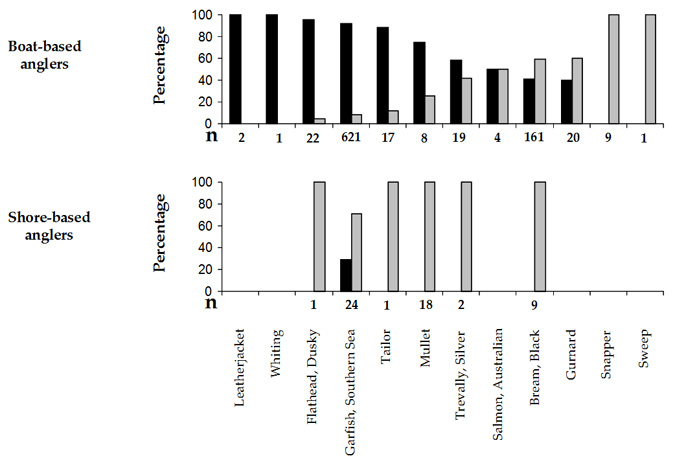
APPENDIX 1E. PERCENTAGE OF RETAINED (BLACK BARS) AND RELEASED (GREY BARS) FISH FOR EACH SPECIES CAUGHT IN LAKE TYERS BY BOAT AND SHORE-BASED ANGLERS PARTICIPATING IN ONSITE SURVEYS FROM JANUARY-APRIL 1999.
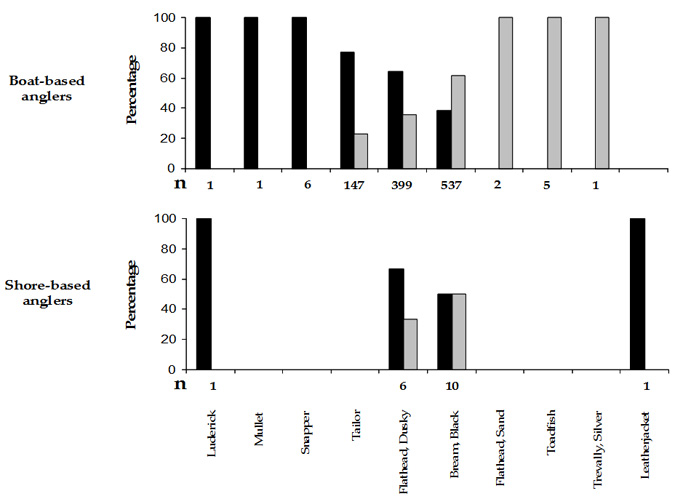
APPENDIX 1F. PERCENTAGE OF RETAINED (BLACK BARS) AND RELEASED (GREY BARS) FISH FOR EACH SPECIES CAUGHT IN LAKE TYERS BY BOAT AND SHORE-BASED ANGLERS PARTICIPATING IN ONSITE SURVEYS BETWEEN DECEMBER 2006 AND JUNE 2007.
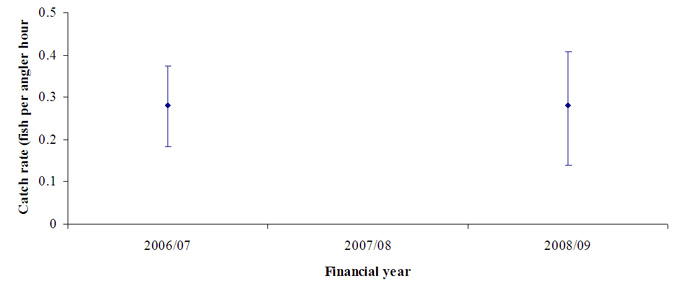
APPENDIX 2A. ESTIMATED MEAN CATCH RATES (± 95% CONFIDENCE LIMITS) OF BLACK BREAM RETAINED BY ANGLERS FISHING IN LAKE TYERS FROM 2006/07 TO 2008/09. NO SAMPLING WAS UNDERTAKEN DURING 2007/08.
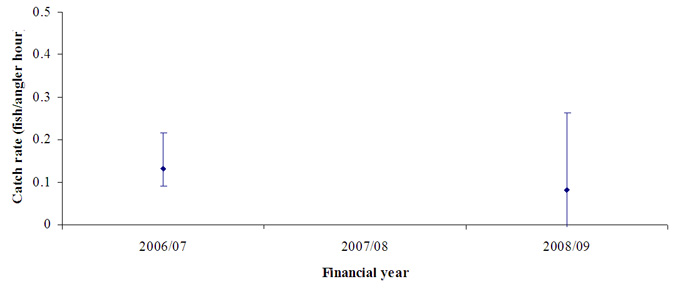
APPENDIX 2B. ESTIMATED MEAN CATCH RATES (± 95% CONFIDENCE LIMITS) OF DUSKY FLATHEAD RETAINED BY ANGLERS FISHING IN LAKE TYERS FROM 2006/07 TO 2008/09. NO SAMPLING WAS UNDERTAKEN DURING 2007/08.
*A LML for black bream of 26 cm was in place at the time of this study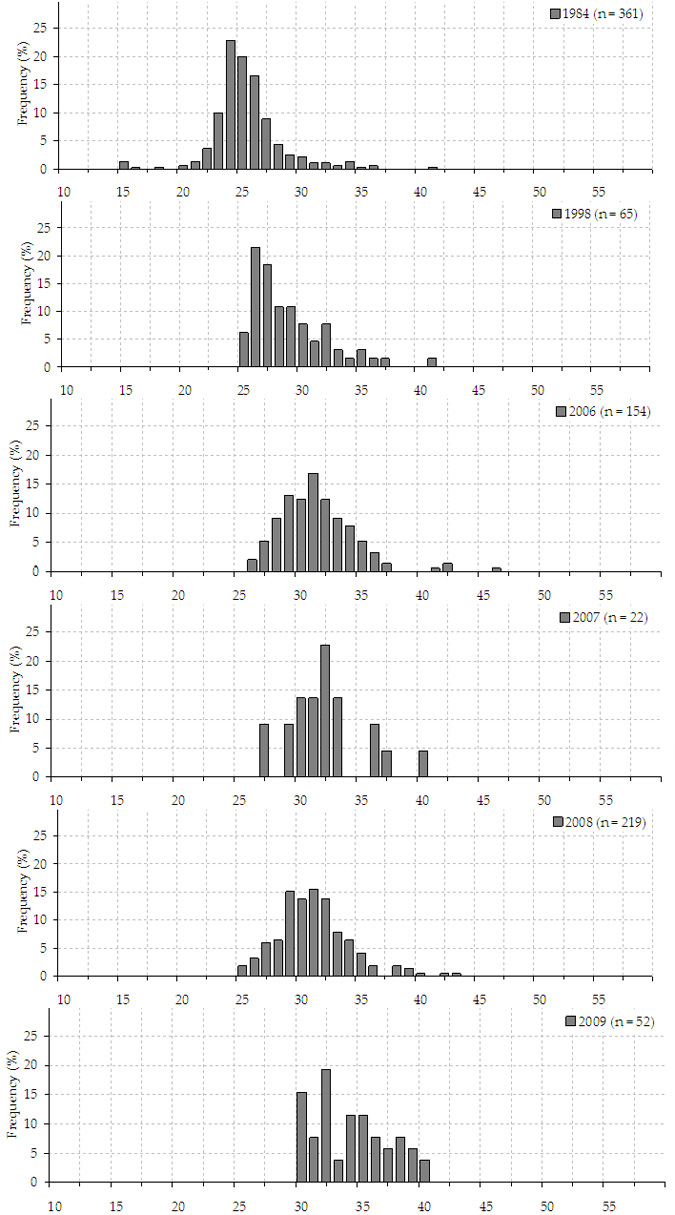
APPENDIX 2C. LENGTH (TL)-FREQUENCY DISTRIBUTION OF BLACK BREAM FROM ACCESS POINT CREEL SURVEYS UNDERTAKEN IN LAKE TYERS FROM 1984 TO 2009 (N=NUMBER OF FISH MEASURED).
